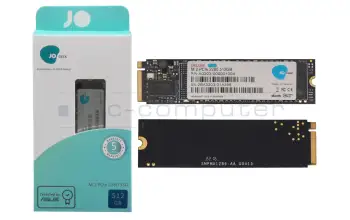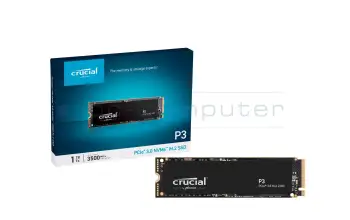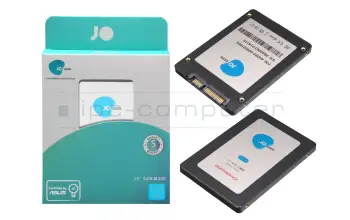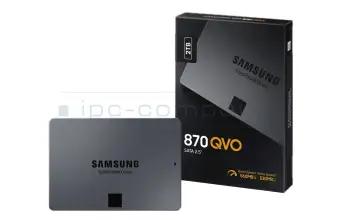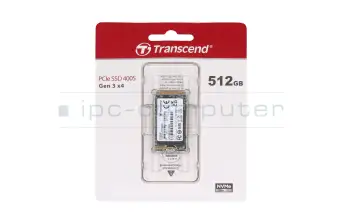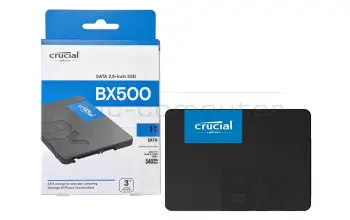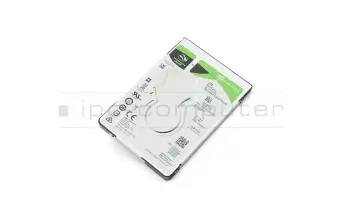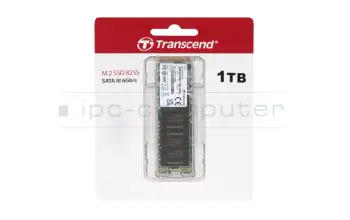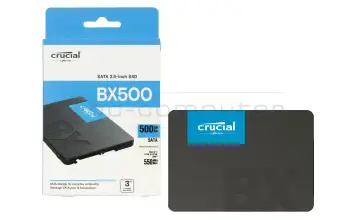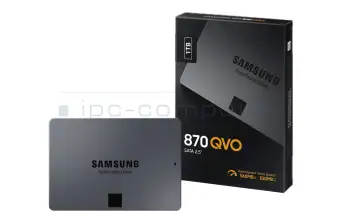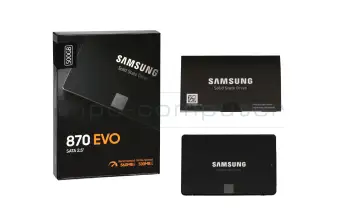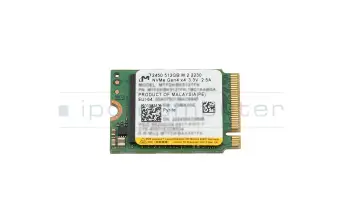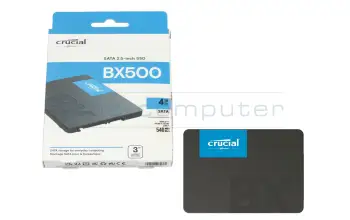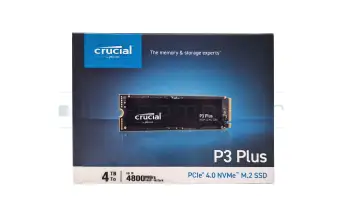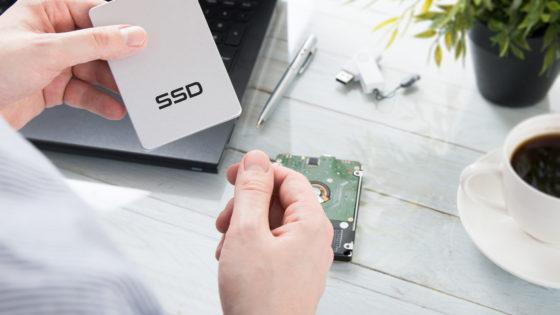Disques durs pour ordinateurs portables, SSD et SSHD
Pourquoi acheter le nouveau disque dur d'IPC-Computer ?
- Qualité originale - s'adapte parfaitement à votre ordinateur portable
- Nouveau maintenant! Nos SSD de la nouvelle marque Asus JoGeek
- Distributeur officiel de pièces détachées de nombreux fabricants d'ordinateurs portables
- Meilleurs prix - livraison rapide
- Échange de disques durs dans notre atelier de réparation d'ordinateurs portables
- Assistance gratuite sur le thème de l'installation du disque dur

Trouver les disques durs appropriés par le modèle ou les caractéristiques
Asus 03B03-00168900 SSD P4X4(VAL-T) 1TB M2 2230 NVME

plus frais d'expédition
Asus 03B03-00169200 SSD P4X4(VAL-T) 1TB M2 2280 NVME

plus frais d'expédition
Asus 03B03-00169800 SSD P4X4(VAL-T) 1TB M2 2280 NVME

plus frais d'expédition
Asus 03B03-00210300 SATA SSD 5300PRO 480GB M2 2280 WOCN

plus frais d'expédition
Asus 03B03-00220000 SSD P3X4 256GB M2 2280 NVME

plus frais d'expédition
Asus 03B03-00220500 SSD S3 256GB M.2 2280/X6106002

plus frais d'expédition
Asus 03B03-00220600 SSD P3X4(PERF) 256GB M2 2280 NVME

plus frais d'expédition
Asus 03B03-00220800 SSDP3X2 256GB M2 2280/80001C00

plus frais d'expédition
Asus 03B03-00220900 SSD P3X2 256GB M2 2280 NVME

plus frais d'expédition
Asus 03B03-00221300 SSDS3 256GB M.2 2280/SBFK61E1

plus frais d'expédition
Asus 03B03-00221500 SSD P3X4 256GB M2 2280 NVME P

plus frais d'expédition
Asus 03B03-00221600 SSD P3X4 256GB M.2 2280/P4101

plus frais d'expédition
Asus 03B03-00221700 SSD S3 256GB M.2 2280/003C

plus frais d'expédition
Asus 03B03-00221800 SSD P3X2(VAL) 256GB M2 2280 NVME

plus frais d'expédition
Asus 03B03-00222000 SSD P3X2 256GB M2 2280 NVME

plus frais d'expédition
Asus 03B03-00222200 SSD P3X2(VAL) 256GB M2 2280 NVME

plus frais d'expédition
Asus 03B03-00222300 SSD P3X2 256GB M2 2280NVMEBRAL

plus frais d'expédition
Asus 03B03-00222500 SSD S3 256GB M.2 2280/M5MA000

plus frais d'expédition
Asus 03B03-00222600 SSDP3X4(PERF) 256G M2 2280 NVME/A004

plus frais d'expédition
Asus 03B03-00223100 SSD P3X2 256GB M2 2280 NVME

plus frais d'expédition
Qu'est-ce qu'un disque dur ?
Le disque dur est souvent appelé familièrement la mémoire de l'ordinateur portable. Il stocke des programmes et d'autres fichiers. Aujourd'hui, on distingue deux technologies principales : le disque dur classique (Hard Disk Drive) et le SSD moderne (Solid State Drive).
Le disque dur est constitué de disques magnétiques rotatifs et d'une tête de lecture. Vous obtenez ainsi beaucoup d'espace de stockage à un prix raisonnable. Bien qu'elle soit très sensible aux chocs ou à un mauvais positionnement et qu'elle doive donc être manipulée avec précaution, elle présente le grand avantage de pouvoir souvent récupérer des données apparemment perdues.
Le SSD fonctionne comme une clé USB, il est constitué de ce qu'on appelle une mémoire flash. L'absence de pièces mécaniques le rend beaucoup plus silencieux et plus résistant aux chocs que le disque dur. Il est également plus léger et fonctionne beaucoup plus rapidement, ce qui le rend particulièrement adapté aux appareils mobiles et au secteur des jeux. Les nombreux avantages ont bien sûr leur prix, le coût par Go est beaucoup plus élevé que celui du disque dur. Dans l'ensemble, cependant, on peut dire que l'installation d'un SSD est certainement utile si vous voulez augmenter la vitesse et les performances de votre ordinateur portable.
La SSHD est une combinaison de HDD et de SSD. Ce disque dur hybride combine la technologie de disque magnétique du HDD avec la mémoire flash du SSD. Il a donc une capacité de stockage considérable, mais fonctionne beaucoup plus vite que le disque dur classique.
| HDD (Hard Disk Drive) | SSD (Solid-State-Drive) | SSD M.2 | SSD M.2 PCIe | |
|---|---|---|---|---|
| Vorschaubild |  |
|  |  |
| Schnittstelle | S-ATA | S-ATA | S-ATA | PCIe 3.0 |
| Protokoll | AHCI | AHCI | AHCI | NVMe |
| Leserate | ca. 133 MB/s | ca. 550 MB/s | ca. 560 MB/s | ca. 3.500 MB/s |
| Schreibrate | ca. 132 MB/s | ca. 520 MB/s | ca. 530 MB/s | ca. 3.300 MB/s |
| Preis | günstig | normal | teuer | sehr teuer |
| Speicherkapazität | bis zu 18 TB | bis zu 4 TB | bis zu 8 TB | bis zu 8 TB |
| Stoßresistenz | weniger robust | robust | robust | robust |
| Lautstärke | laut | leise | leise | leise |
| Stromverbrauch | hoch | gering | gering | gering |
| Langlebigkeit | 3-5 Jahre | bis zu 10 Jahre | bis zu 10 Jahre | bis zu 10 Jahre |
| Datenwiederherstellung | einfach | schwierig | schwierig | schwierig |
De quoi dois-je tenir compte lors de l'achat d'un disque dur ?
Le nouveau disque dur doit correspondre à l'ancien, tant dans son type d'interface que dans sa conception. Le type d'interface est principalement différencié entre SATA et SAS, seuls les disques durs SATA étant installés dans les ordinateurs portables. Ceux-ci sont à nouveau disponibles en plusieurs versions. Le dessin, ou aussi appelé facteur de forme, doit également être pris en compte. Dans les ordinateurs fixes, des disques durs de 3,5 pouces sont installés, alors que les ordinateurs portables d'aujourd'hui contiennent principalement des disques durs de 2,5 pouces ou M.2.
Vous ne savez pas quel disque dur convient à votre ordinateur portable ? Avec notre outil de recherche de disque dur, ce n'est pas un problème, il suffit d'entrer les valeurs respectives et vous obtiendrez le disque dur correspondant.
Interessante Beiträge Rund um das Thema Notebook Festplatten und SSD's
Notebook Hard Drives / HDD FAQ
All important questions and answers surrounding hard drives
- Why doesn't my new hard drive show up in the operating system?
New hard drives are often delivered unpartitioned, the user can decide for himself what kind of file system he would like to use. The Windows Explorer will not recognize these and won’t display them. You can take a look at our FAQ “How can I format or partition a hard drive?” to partition and be able to use your new drive.
See also: - What hard-drive tools are there?
Our notebook technicians use the following tools for checking the health of disk:
- CrystalDiscInfo (Freeware)
This tool reports all kinds of data concerning the hard drive, like power-on hours and S.M.A.R.T. values.
- HD-Tune Pro (Shareware)
This tool offers a great sector test, whose result is displayed graphically.
If single sectors of a disk are defective, the data can be cloned to another hard drive. Our technicians use the following tools for this:
- Norton Ghost
- Acronis True Image
- Paragon Disc Manager
When installing a Samsung SSD in your notebook you can use their “Magician” Tool to migrate your data to the new SSD. It is included in the delivery of our Samsung SSD's.
- CrystalDiscInfo (Freeware)
- Are the S-ATA standards compatible?
Yes, the SATA standards are compatible to each other, however the slowest involved connection type will always be used. This means that connecting a SATA 6Gb/s SSD to a SATA 3Gb/s controller will severely limit its peak performance.
More information can be found in the FAQ “What is the difference between P-ATA (IDE), S-ATA, S-ATA II and S-ATA III?”
- Why is the size of my harddrive that Windows reports less that what the manufacturer advertised?
Harddrive manufacturers calculate the size using a base of one thousand. That means that 1 KB = 1000 Byte. However the more common calculation uses a base of 2 to the power of 10 or 1 Kb = 1024 Byte.
This small difference appears when going from Byte to KB, to MB and to GB that is why in the end there is a sizable difference between advertised and usable capacity.
- What is the difference between 512n and 512e
On a hard drive there are so-called sectors. These are the smallest parts than can be read or written to the disk. Traditionally they were 512 Bytes in size. But this allows only so much data to be stored with a given number of sectors. That is why 4 Kilobyte sectors where introduced, these can store eight times the data of 512 Byte sectors. However, not every Operating System and every application were compatible with these larger sectors. This is why manufactures introduced emulated 512 Byte large sectaries (512e). With these the hard drive splits the four Kb sectors into eight 512 Byte sectors, so the OS thinks, that the hard drive has 512 Byte sectors. 512n stand for those drive which have native 512 Byte sectors.
- What is S.M.A.R.T. and what is it for?
To increase the reliability of hard drives and the data security hard drive manufacturers have developed the Self-Monitoring Analysis and Reporting Technology (S.M.A.R.T.). it can read important information about the drive like temperature, power-on time and read-/write errors.
- What do I have to look out for with M.2 drives?
First thing to consider is the size of the drive. Most M.2 SSDs come in the 2280 form factor. The first two digits indicate the width of the drive in millimeters and the last two, sometimes three digits its length. Other sizes for M.2 cards are 2242, 2260 and 22110, which is sometimes found in servers.
The other difference is in the protocol the drive uses to communicate with the PC. Often less expensive M.2 SSDs still use the SATA protocol, which is also used by drives with more common formfactors. Even though it is rather slow for an SSD, it should still be fast enough for most users. Modern, high-performance M.2 drives use the NVMe protocol which is transmitted via PCI Express. Oftentimes slots, which support PCIe also support SATA, but bevor buying a drive, double check that it is fully compatible.
There are also certain keys, which can give away information about the type of connection used. An SSD with only the M-Key usually uses PCI Express, whereas an SSD with the M- and the B-key usually uses the SATA protocol. The A- and E-key is often used for Wi-Fi cards.

- What hard drive can I install in my Notebook?
You have to pay attention, that your hard drive uses the same connection type and form factor or height.
With the very common 2.5” hard drives you have to check whether your notebook still uses the old PATA standard or SATA and also you have to check what height is compatible since there are multiple heights. 7mm, 9mm and 15mm are the most common ones.
For SSDs there are also small form actors like mSATA or M.2. With the latter one you have to check if the slot supports the SATA and/or PCIe (NVMe) protocol.
The only thing that is not limited is the capacity and speed of your new drive.
- What file system should I use?
The most used file systems are:
- FAT 16, FAT 32 (Windows 95, 98, ME, XP)
- NTFS (Windows NT, 2000, XP, Vista, 7, 8, 8.1)
- EXT 2 (Linux)
- HFS, HFS+ (Apple Macintosh)
However nowadays most Windows computers use NTFS for their hard drives
The various FAT formats are only used in USB sticks or memory cards.
- How can I make sure my data is safe and prevent data loss?
Just like detailed in the FAQ “What is S.M.A.R.T. and what is it for?” S.M.A.R.T. is an industry standard for the constant monitoring of disk parameters like temperature and read- or write errors. With its help errors can be detected before they happen, the data can be backed up and the drive replaced.
However even with careful monitoring the death of a hard drive can always happen unexpectedly. This is why it is very important to back up important data like invoices or family photos to an external hard drive or the cloud. This should be done in regular intervals so that you always have a complete backup of your data.
If your hard drive breaks a data recovery is expensive and time consuming and not always possible.
See also:
The operation in a notebook does not prolong the life of a hard drive. First this is because of the shock and vibrations when moving the device. This can cause the read/write head to crash into the platters in the wort case breaking this head. Move your device carefully while it is on, or even better avoid moving it at all. Secondly, due to the compact formfactor notebooks usually get very warm. That is why putting your device on a notebook cooler can improve the performance and lifespan of your device. Modern solid-state drives are a lot more resilient to shock and heat and therefore more durable, than traditional hard drives. - How can I format or partition a hard drive?
You can use the disk management utility built into Windows 10.
- Hit the Windows key and type "Control Panel", then hit enter
- Left click on Administrative Tools
- Select Computer Management and then Disk Management.
- After a short loading time you will be shown all connected drive with their respective partitions.
- Right click on the unformatted drive and click format.
- Follow the wizard to complete the formatting process.



- Wie öffne ich mein Laptop fachgerecht – und worauf muss ich beim SSD Tausch achten?
Das Öffnen eines Laptops erfordert Sorgfalt, das richtige Werkzeug und etwas Erfahrung.
Grundregeln beim Öffnen:
- Gerät vollständig vom Strom trennen und, falls möglich, Akku entfernen bzw. stromlos schalten.
- Geeignetes Feinmechanik‑Werkzeug und ESD‑Schutz verwenden.
- Gehäuseschrauben systematisch lösen und Bodenabdeckung vorsichtig mit einem Kunststoff‑Tool abheben.
- Keine Gewalt anwenden – viele Geräte besitzen versteckte Schrauben unter Gummifüßen oder Aufklebern.
In unserer Reihe „Mein Laptop von innen“ zeigen wir anschaulich, wie verschiedene Notebook‑Modelle aufgebaut sind und welche Schritte nötig sind, um sie sicher zu öffnen.
Die Videos helfen dir, die Bauweise unterschiedlicher Marken (z. B. HP, Lenovo, Dell, Acer) besser zu verstehen und zeigen, wo sich Akku, Mainboard oder RAM befinden.
Wenn du dir beim Öffnen unsicher bist oder fest verbaute Komponenten besitzt, übernehmen unsere Techniker in der Werkstatt den sicheren Ausbau und die Reparatur. - How do I swap a hard drive and what do I have to watch out for?
When swapping out your hard drive please also attach the mounting bracket from the old one to the new one. You also have to be extremely careful not to damage any of the plugs and connectors on the mainboard or the drive.

- Where is the difference between HDD, SSD and SSHD?
HDDs or hard disk drives are the most common way of storing large amounts of data in a computer. The data is stored on spinning disks coated with a magnetic material, when writing the polarization of a small part of this coating is reversed by the read-write-head. The polarization can be read by the head later on, to retrieve the data stored on the disks. Since the platters are turning, the read-write head often has to wait until the right part of the disks is under it, to read/write data. This makes HDDs a relatively slow storage medium, especially for randomly accessed data. However, through continuously shrinking the individual magnetic parts and increasing the number of platters per drive, a lot of data can be stored on them. In 2017 it was already up to 14TB per drive.
Unlike HDDs, SSDs or solid-state drives have no moving parts. The information is stored with the help of transistor. This means that no time is wasted waiting for the right part of the platter to arrive to read/write to/from it, therefore SSDS are a lot faster. For one of the fastest SSDs on the market the manufacturer claims speeds up to 3,5GB/s, that is more than 16 times as much as a modern HDD. Additionally, SSDs are much more rugged and long-lived due to the lack of moving parts. Unfortunately, they are a lot more expensive per GB than HDDs and the biggest consumer drives are "only" 4TB in size.
SSHDs, which is short for solid state hybrid drives are a combination of HDDs and SSDs. A small SSD, often 8 to 16 GB is used to cache the data for a 1 to 2 TB HDD. In the cache frequently accessed data and data, that has just been written is stored making the drive a lot faster, when accessing this data. However, when accessing infrequently used data or writing a lot of data to the drive, the solid-state cache can no longer be used and performance drops to the level of an HDD.
If you are interested in buying a new drive, our shop has a lot of different types of drives.
- What is the difference between P-ATA (IDE), S-ATA, S-ATA II and S-ATA III ?
The difference is in the type of connection and its speed.
- P-ATA/IDE (IDE 100/133) Parallel connection with transfer rates of up to 1 Gbit/s or 100 MB/s to 133 MB/s.
- S-ATA (SATA 150) Serial connection with transfer rates of up to 1.5 Gbit/s or 150 MB/s.
- S-ATA II (SATA 300) Serial connection with transfer rates of up to 3.0 Gbit/s or 300 MB/s.
- S-ATA III (SATA Revision 3.0) Serial connection with transfer rates of up to 6.0 Gbit/s or 600 MB/s.


